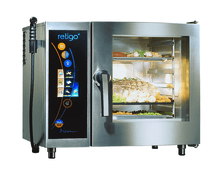Combi steamer


A combi steamer (or combi-steamer) is a professional cooking appliance that combines the functionality of a convection oven and a steam cooker. That is, it can produce dry heat, moist heat or a combination of the two at various temperatures. The appliance is therefore fit for many culinary applications, including baking, roasting, grilling, steaming, braising, blanching and poaching. The advantages of this technology are short cooking times and a gentle preparation method, both of which lead to enhanced vitamin and nutritional preservation when compared to traditional cooking methods.
The main modes of operation are steam, convection (circulation of hot air) and a combined variant of food preparation (simultaneous use of vapor and hot air).
History
The first combi steamer was invented in the 1960's by the company Burger Eisenwerke (which later took over the company Juno). The company is today a part of Electrolux and sells its products as Electrolux professional.
In 1976, German company Convotherm released its first combi-steamer oven. Since then, more and more chefs started choosing combi-steamer ovens as a modern alternative to conventional cookers, woks and boilers. This technology saves time, energy and raw materials.
In 1976, another German company, RATIONAL, followed with an appliance combining the functionality of a convection oven and a steam cooker. Owing to combi steamers, cooks could apply methods of cooking that reduced electricity and water use, lowered production time and minimized final product losses. Gentle steaming using low temperature vapor led to an increased preservation of vitamins and nutritional value in prepared foods, resulting in the extensive use of the appliance for the preparation of dietary dishes.
Combi steamers gradually transformed from simple appliances with manual water injection into multifunctional machines, many of which have their own "intelligence" and possibility of automatic food preparation based on pre-programmed recipes.
Initially, the price was very high and they were popular for expensive public catering establishments. Later combi steamers became an integral part of kitchen equipment for many kinds of restaurants and for private households, especially in Europe.
Types of combi steamers
Classification of combi steamers:
- by methods of vapor generation:
- boiler (using steam generator)[1]
- injective (vapor is generated by injecting water directly to the heating element as required)
- by control types:
- mechanical
- electromechanical
- electronic (touch-sensitive)
- by capacity:
- small (3-6 levels), typically for households
- medium size (6-10 levels)
- large (12-24 levels)
Advantages
The advantages of a combi steamer over other thermal equipment include:
- control of both temperature and humidity in the chamber, which reduces cooking time
- uniform preparation
- lower temperatures preserve nutrients
- simultaneous processing of up to 12 different dishes without mingling of flavours
- food preparation without oil or fat; reduced carcinogen formation
- reheating previously prepared food without loss of moisture, or of crispness[2]
- space saving, fewer kitchen appliances needed
- reduction of final product shrinkage losses
- electricity savings
- reduction of labour costs
- self-cleaning
Principal producers
- Australia/New Zealand: Convotherm
- Italy: Tecnoeka, Angelo Po, Lainox, Foinox, Gico, Electrolux Professional, Gierre, Unox, Olis, Zanussi (part of Electrolux).
- Germany: Convotherm, RATIONAL, MKN, ELOMA, Kuppersbusch, Miele, AEG (part of Electrolux),Bosch.
- Switzerland: V-Zug
- Czech Republic: Retigo
- France: Bourgeois
- Spain: Fagor
- South Korea: LG Electronics
- Russia: Abat (Chuvashtorgtechnika)
- United States of America: AccuTemp Products, Alto-Shaam, Blodgett Oven Company, Winston Industries[3]